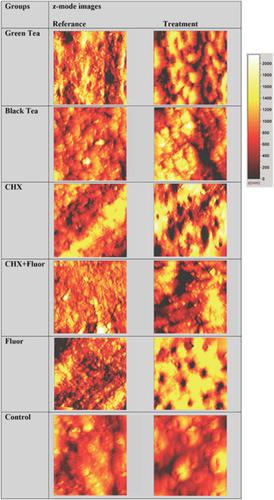当前位置:
X-MOL 学术
›
Microsc. Res. Tech.
›
论文详情
Our official English website, www.x-mol.net, welcomes your
feedback! (Note: you will need to create a separate account there.)
Effect of black tea and matrix metalloproteinase inhibitors on eroded dentin in situ.
Microscopy Research and Technique ( IF 2.0 ) Pub Date : 2020-03-20 , DOI: 10.1002/jemt.23475 Gunce Ozan 1 , Hande Sar Sancakli 1 , Taner Yucel 1
Microscopy Research and Technique ( IF 2.0 ) Pub Date : 2020-03-20 , DOI: 10.1002/jemt.23475 Gunce Ozan 1 , Hande Sar Sancakli 1 , Taner Yucel 1
Affiliation

|
Purpose of this in situ study was to evaluate the surface properties of eroded dentin specimens activated with three different matrix metalloproteinase (MMP) inhibitors (chlorhexidine [CHX], fluoride, green tea), black tea, and water. One hundred eighty dentin samples were prepared from extracted third molars and then samples divided into six groups. Ten volunteers were carried three specimens of each group, on acrylic palatal appliances, which were fabricated exactly for them (n = 3). Erosive cycles were done by immersing appliances in cup containing Cola and was followed by rinsing with test solutions. Microhardness values were measured. Surface properties were investigated by atomic force microscopy (AFM). Lowest change in microhardness was shown in fluoride group whereas negative control group (water) had the highest change. There were no statistically significant differences among surface roughness changes (p > .05). The least change in microhardness was seen in the fluoride group (13.05 ± 8.07), while the control group showed the highest change (33.80 ± 12.42) and was statistically significant when compared to other groups (p < .05). Besides lowest depth, values were shown in fluoride group as well. AFM evaluations showed macromolecular deposits on surfaces of fluoride, CHX, and black tea groups. No superior results were detected in CHX + fluoride group and black tea showed similar surface characteristics as green tea. Mouthrinses containing not only green tea but also black tea could be beneficial for patients with exposed dentin surfaces. Catechines and theaflavins in teas could be useful for improving surface quality.
中文翻译:

红茶和基质金属蛋白酶抑制剂对侵蚀牙本质的影响。
这项原位研究的目的是评估被三种不同的基质金属蛋白酶(MMP)抑制剂(洗必泰[CHX],氟化物,绿茶),红茶和水激活的侵蚀的牙本质标本的表面特性。从提取的第三磨牙制备一百八十个牙本质样品,然后将样品分为六组。十名志愿者在丙烯酸acrylic器上进行了每组三个标本的制作,这些标本正是为他们准备的(n= 3)。通过将器具浸入装有可乐的杯子中进行侵蚀循环,然后用测试溶液冲洗。测量了显微硬度值。通过原子力显微镜(AFM)研究表面性能。氟化物组的显微硬度变化最低,而阴性对照组(水)的变化最高。表面粗糙度变化之间没有统计学上的显着差异(p > .05)。氟化物组的显微硬度变化最小(13.05±8.07),而对照组的变化最大(33.80±12.42),与其他组相比,具有统计学意义(p <.05)。除最低深度外,氟化物组也显示值。AFM评估显示,氟化物,CHX和红茶组表面存在大分子沉积物。CHX +氟化物组未检测到优异的结果,红茶的表面特性与绿茶相似。含有绿茶和红茶的漱口水可能对牙本质裸露的患者有益。茶中的儿茶素和茶黄素可用于改善表面质量。
更新日期:2020-03-20
中文翻译:

红茶和基质金属蛋白酶抑制剂对侵蚀牙本质的影响。
这项原位研究的目的是评估被三种不同的基质金属蛋白酶(MMP)抑制剂(洗必泰[CHX],氟化物,绿茶),红茶和水激活的侵蚀的牙本质标本的表面特性。从提取的第三磨牙制备一百八十个牙本质样品,然后将样品分为六组。十名志愿者在丙烯酸acrylic器上进行了每组三个标本的制作,这些标本正是为他们准备的(n= 3)。通过将器具浸入装有可乐的杯子中进行侵蚀循环,然后用测试溶液冲洗。测量了显微硬度值。通过原子力显微镜(AFM)研究表面性能。氟化物组的显微硬度变化最低,而阴性对照组(水)的变化最高。表面粗糙度变化之间没有统计学上的显着差异(p > .05)。氟化物组的显微硬度变化最小(13.05±8.07),而对照组的变化最大(33.80±12.42),与其他组相比,具有统计学意义(p <.05)。除最低深度外,氟化物组也显示值。AFM评估显示,氟化物,CHX和红茶组表面存在大分子沉积物。CHX +氟化物组未检测到优异的结果,红茶的表面特性与绿茶相似。含有绿茶和红茶的漱口水可能对牙本质裸露的患者有益。茶中的儿茶素和茶黄素可用于改善表面质量。











































 京公网安备 11010802027423号
京公网安备 11010802027423号